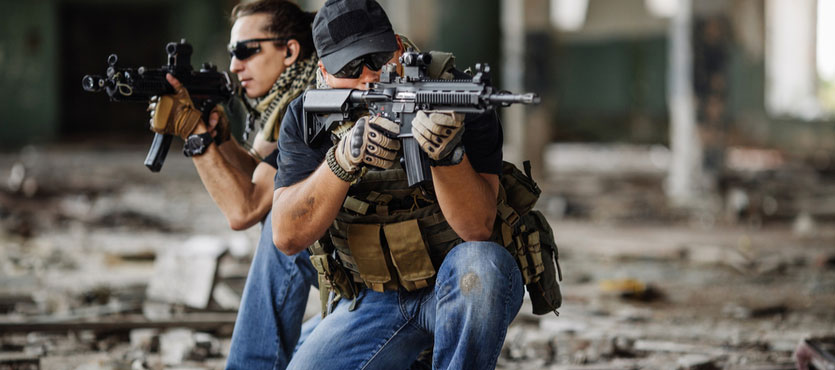A federal appeals court ordered the resentencing of three former Blackwater contractors who received long prison sentences on manslaughter charges, and threw out a fourth contractor’s murder conviction altogether.
The case goes back to 2007, when a group of Blackwater guards protecting a convoy opened fire in a crowded city square in Iraq. They insisted that they were fighting off insurgents and that they had intelligence that a white Kia may have been carrying a car bomb, while witnesses and federal prosecutors contend that the men fired upon the crowd indiscriminately. About the only certain fact is that, when it was all over, 31 people were dead or injured.
Just as the trials were getting started, the Justice Department, under intense pressure from the FBI, charged Dustin Heard, Evan Liberty, and Paul Slough with manslaughter using machine guns, a crime that carries a mandatory 30-year sentence. But the appeals court ruled that the enhancement charge applied only in cases wherein a person intentionally brings a dangerous weapon to a conflict, and the three Blackwater contractors were simply using the weapons they had been issued. The result was sentences that were “grossly disproportionate to their culpability for using government-issued weapons in a war zone,” according to the three-judge panel.
The panel entirely threw out the murder conviction of Nicholas Slatten, a sniper who allegedly fired the first shot. The court ruled that Mr. Slatten should have been tried separately, as the case against him “hinged on his having fired the first shots,” and one of the other co-defendants testified that he, not Mr. Slatten, fired first.
The Trump administration has not indicated whether it will retry Mr. Slatten, as such an undertaking would be a daunting task. Prosecutors must track down and transport witnesses to an event that took place over 10 years ago, and many observers said that the evidence against the group was much stronger than the evidence against Mr. Slatten as an individual.
Contractors in Iraq
After a brief falloff, contractor presence in Iraq surged more than eightfold in 2016, from about 250 contractors to more than 2,000. Almost 6,000 more are in-country working for non-DoD agencies, such as the State Department or the CIA. About 30% of the DoD contractors serve in logistical or supply capacities, 20% are translators, and 13% fill base support roles. Most of these individuals come from the large Logistics Civil Augmentation Program contractors, like Fluor, KBR, and DynCorp.
Contractor numbers have been consistently high in Iraq, despite incidents like the Nisour Square “massacre,” largely because of cost and flexibility. Although contractors receive higher wages, they receive no benefits and are paid only for the time they spend in-country. Furthermore, according to RAND Analyst Rick Brennan, such an arrangement “makes tailoring a unit much more responsive to the needs of the commander because you do not have to try to rip people [with a trade specialty] from other installations.”
Injury Compensation
One salient feature of an anti-insurgency campaign is that there are no front lines, and so all soldiers are almost equally at risk. This is the kind of environment that the 1941 Defense Base Act is designed to address.
The DBA was passed on the eve of America’s entry into World War II, and many lawmakers undoubtedly envisioned U.S. military forces, and their accompanying private contractors, to serve peacekeeping-type roles after the fighting had ended. At the same time, greybeards in Congress at the time still remembered the long, bloody insurgency in the Philippines that the Americans inherited from the Spanish when they took over the islands in 1899. If you like foreign war movies, you may want to check out 1898: Los Ultimos de Filipinas (Our Last Man in the Philippines).
Part of the compensation package includes money for lost wages. Most victims receive two-thirds of their average weekly wage until they can go back to work.
There are some exceptional circumstances. Many doctors allow victims to return to light duty work part of the way through their recoveries. If that is the case, if such work is available, and it pays less than their prior positions, victims are entitled to two-thirds of the difference between pay until they can go back to their old jobs.
Furthermore, some victims are permanently disabled. In these cases, the insurance company usually pays a lump sum based on the type of loss, such as a hand or eye, as well as the extent of the disability. Such permanent disability may become apparent straightaway, or victims may reach their maximum medical improvement during physical therapy before they are 100% whole.
Additional compensation is available for other economic losses, such as medical bills. These benefits are available on a no-fault basis for all medical care from emergency treatment through physical therapy. Typically, the insurance company pays these medical expenses directly, the injured victims never see medical bills, and they are not responsible for any unpaid charges.
For more information about the procedure to obtain benefits under the DBA, contact Barnett, Lerner, Karsen & Frankel.

